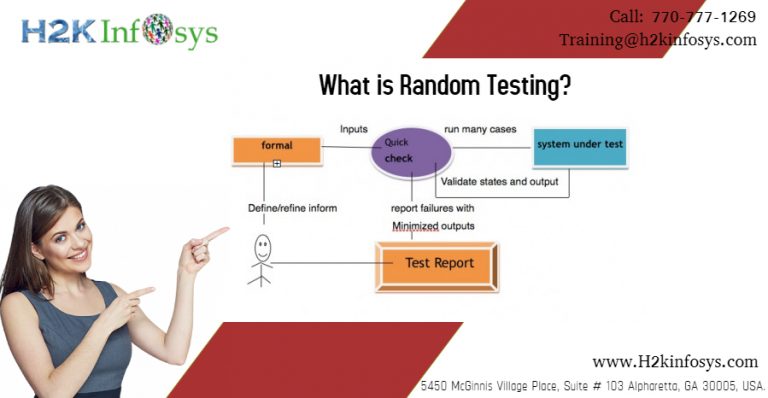Introduction
Software testing and quality assurance are critical components of the software development lifecycle. As a QA tester, ensuring software stability and reliability is a key responsibility. One often-overlooked but highly effective technique is random testing. This method helps identify unexpected software defects that structured methods may miss.
In this blog, we will explore what random testing is, how it works, its benefits, and real-world applications. If you are considering a QA tester training or a QA software tester course, understanding random testing will enhance your software skills and job prospects.
What is Random Testing?
This also known as monkey testing, is a black-box technique where test inputs are randomly generated and applied to the system under test. The primary goal is to identify defects that structured testing techniques might overlook by simulating unpredictable user interactions.
Instead of following predefined test cases, testers or automated tools generate random inputs to observe how the system responds. If unexpected crashes or errors occur, testers investigate further to determine the root cause.
Key Characteristics of Random Testing
- Black-box approach: No knowledge of the internal code structure is required.
- Unscripted test execution: Inputs are generated randomly.
- Exploratory in nature: Often used to detect edge cases.
- Low-cost implementation: No need to write test cases manually.
Why is Random Testing Important in Software Testing?
1. Detects Unexpected Bugs
Its helps uncover bugs that structured techniques may not predict. Edge cases and unexpected user interactions often lead to software failures.
2. Simulates Real-World User Behavior
Real users do not always follow a predictable pattern. Is mimics Chaotic user interactions, making it a valuable tool for software stability.
3. Improves Software Resilience
By exposing software to a variety of unpredictable inputs, random testing ensures robustness against unexpected user behavior and security threats.
4. Cost-Effective Testing
Since no detailed test cases are needed, random testing can be implemented quickly, making it an efficient method for initial testing phases.
Random testing is a technique where programs are tested by generating random and independent inputs. It is a type of black box testing. The results of output generated are compared with the software specifications to verify if the result is correct or not. There are some strengths and weakness.
The strength of random testing are:
- It is inexpensive to use
- It does not have any bias
- The bugs are found very easily and quickly
- If software is used properly it will find the bugs.
The weakness of this testing is:
- It is capable of finding only basic bugs
- It is precise when specifications are imprecise.
- This technique compares poorly with other techniques to find the bugs
- This technique will create a problem for continuous integration if different inputs are randomly selected on each test.
- Some think that white box testing is better than this technique
The characteristics of random testing:
- It is performed where defects in a software application is not identified by the regular intervals.
- Random input is used to test the system performance and its reliability.
- Saves time and effort than actual tests.
- Other testing methods are not used.
The common example of Random testing is: use of random integers to test the software function that returns the results based on those integers. Specifically when dealing with integers or other types of variables. random as a set of random inputs that are used, in other words testers are bound to choose set of integers rather than infinite set.
Types of Random Testing:
With respect to the input
Random input sequence generation, random sequence of data inputs and random data selection from existing database.
Guided vs Unguided
Undirected random test generation with no heuristics to guide its search and directed random test generation.
Most of the criticism about random testing is about misapplication of the technique. The key problem of random test is generating input that are part of the domain of the software under test.
- fault behaviour
- data validation
- Adherence to specifications
- Concurrency
How Random Testing Works: Step-by-Step Guide
Step 1: Define the Test Scope
Identify the software components where random testing will be applied. This could be a web application, mobile app, or API.
Step 2: Generate Random Inputs
Use tools or scripts to generate random test inputs. These inputs could include:
- Random keyboard entries
- Random mouse clicks
- Random API requests
Step 3: Execute the Test
Run the generated inputs on the software. Observe system responses, crashes, or unexpected behaviors.
Step 4: Log and Analyze Errors
If the system fails, capture logs, screenshots, or error messages for further analysis.
Step 5: Report and Fix Defects
Report the identified defects to the development team and retest once fixes are applied.
Real-World Applications of Random Testing
1. Mobile App Testing
Random testing is widely used in mobile applications to ensure smooth user experience. QA testers generate random touch inputs, gestures, and device rotations to evaluate app stability.
2. Web Application Testing
For web applications, helps identify unexpected behaviors due to varied user interactions, such as random form submissions, clicking on broken links, or stress-testing the UI.
3. Security Testing
Cybersecurity testers use random testing to generate unpredictable inputs to check for vulnerabilities like SQL injection and buffer overflows.
4. API Testing
Random API requests help assess how a system responds to invalid, malformed, or unexpected requests, ensuring robust backend operations.
Benefits of Random Testing in Software Quality Assurance
Random testing, also known as monkey testing or stochastic testing, is a powerful yet often underutilized method in the realm of software quality assurance. By generating random inputs and feeding them into the system, random testing aims to uncover unexpected errors and edge cases that might be missed by structured approaches. Here are some key benefits of incorporating into your Quality Assurance process:
Uncovers Hidden Bugs: One of the most significant advantages of random testing is its ability to expose hidden defects that might not be detected by traditional test cases. Since random inputs are not predetermined, they can help reveal software behavior under unexpected conditions, which is crucial for improving overall reliability.
Enhances Test Coverage: Random testing can dramatically expand test coverage beyond what is typically achievable with manual or automated scripted tests. It explores scenarios that may not have been considered during the design phase, thus increasing the robustness of the application.
Saves Time and Resources: Random testing can be automated and run continuously without the need for detailed test cases or extensive planning. This allows QA teams to test more frequently and at a lower cost, identifying issues early in the development lifecycle.
Stress Testing Capabilities: Random testing is particularly effective for stress testing applications. By inputting a large volume of random data, testers can observe how the system handles extreme conditions, ensuring that the application remains stable and performs well under unexpected or high-load scenarios.
Challenges of Random Testing
While random testing offers numerous benefits, it also comes with its own set of challenges. One primary concern is the difficulty in reproducing errors since the inputs are randomly generated. This can make it challenging to diagnose and fix the underlying issues. To mitigate this, testers can log input data and system responses during each test run, enabling them to trace and reproduce specific bugs when necessary.
Best Practices for Implementing Random Testing
1. Use Automated Tools
Manually generating random inputs can be inefficient. Leverage tools like:
- MonkeyRunner (for Android app testing)
- Fuzz Testing Tools (for security testing)
- Selenium with Random Data Generators (for web testing)
2. Monitor and Log Failures
Capture all system behaviors, crashes, and error messages for effective debugging and defect reporting.
3. Combine with Other Testing Methods
Random testing should not replace structured testing but rather complement it. Use it alongside functional and regression for comprehensive QA coverage.
4. Run Tests in Different Environments
Test across multiple devices, browsers, and operating systems to identify environment-specific defects.
5. Prioritize Critical Components
Random testing is most effective when applied to critical software components that impact user experience and security. strategy, you can enhance your application’s resilience and deliver a more reliable user experience.
Case Study: Random Testing in Action
Company: A leading e-commerce platform
Challenge: Frequent application crashes due to unpredictable user inputs.
Solution: The QA team implemented random testing using Selenium and Python scripts to generate random user actions, such as clicking buttons, filling forms, and navigating pages unpredictably.
Outcome: The team identified several high-priority defects related to unhandled input exceptions, leading to significant improvements in application stability and user experience.
QA Training and Placement: Mastering Random Testing at H2K Infosys
Random testing is a vital technique for any software tester. If you are looking to enhance your skills in QA testing courses, H2K Infosys offers an industry-leading QA software tester course that covers all aspects of software and quality assurance.
What You’ll Learn:
- Comprehensive software testing and quality assurance course content
- Hands-on projects with real-world applications
- Training from industry experts with years of experience
- Assistance in QA training and placement
Key Takeaways
- Random testing is a valuable QA technique for detecting unpredictable software defects.
- It improves software resilience, enhances security, and is cost-effective.
- Random testing can be used in mobile apps, web applications, API testing, and security testing.
- Automated tools like Selenium, MonkeyRunner, and fuzz testing tools enhance efficiency.
- A structured approach ensures better bug detection and improved software quality.
Conclusion
Ready to take your QA career to the next level? Enroll in H2K Infosys‘s QA training and placement program today and gain hands-on experience with random testing and other essential QA techniques!



























22 Responses
1. Random testing is a type of black box testing.It is a testing technique where programs are tested by generating random and
independent inputs. The results of output generated are compared with the software specifications to verify if the result is
correct or not. There are some strengths and weakness of random testing.
Random testing is great for testing:
Fault behavior
Data validation
Adherence to specifications
Concurrency
2. The characteristics of random testing:
– It is performed where defects in a software
– Application is not identified by the regular intervals.
– Random input is used to test the system performance and its reliability.
– Saves time and effort than actual tests.
– Other testing methods are not used.
Random testing is a testing technique where programs are tested by generating random and independent inputs. It is a type of black box testing. The results of output generated are compared with the software specifications to verify if the result is correct or not. There are some strengths and weakness of random testing.
The characteristics of random testing:
It is performed where defects in a software application is not identified by the regular intervals.
Random input is used to test the system performance and its reliability.
Saves time and effort than actual tests.
Other testing methods are not used.
The common example of Random testing is: use of random integers to test the software function that returns the results based on those integers. Specifically when dealing with integers or other types of variables. Random testing is random as a set of random inputs that are used, in other words testers are bound to choose set of integers rather than infinite set.
Random testing to test the software application by randomly generated inputs to look for any defects.This is part of the black box testing.
Characteristics include: This test is implemented to test the application to find out defects if they are not identified during intervals.
It is inexpensive, it is better than white box testing. This is to check the performance and reliability of the software. save time and effort than actual tests.
Random testing is a testing technique where programs are tested by generating random and independent inputs. It is a type of black box testing. The results of output generated are compared with the software specifications to verify if the result is correct or not. Here basic bugs are found very easily and quickly if software is used properly .
The common example of Random testing is: use of random integers to test the software function that returns the results based on those integers. Specifically when dealing with integers or other types of variables. Random testing is random as a set of random inputs that are used, in other words testers are bound to choose set of integers rather than infinite set.
The characteristics of random testing:
It is performed where defects in a software application is not identified by the regular intervals.
Random input is used to test the system performance and its reliability.
Saves time and effort than actual tests.
Other testing methods are not used.
This technique will create a problem for continuous integration if different inputs are randomly selected on each test.
Random testing- it is the testing technique with random or independence inputs. It is the black box testing.
Characteristics of Random testing:
It is performed where defects in a software application is not identified by the regular intervals. it saves time and effort than actual tests.
What is random testing?
Random testing is a black-box software testing technique where programs
are tested by generating random, independent inputs.
Results of the output are compared against software specifications
to verify that the test output is pass or fail.
What are the characteristics of random testing
The characteristics of random testing:
It is performed where defects in a software application is not
identified by the regular intervals.
Random input is used to test the system performance and
its reliability.
Saves time and effort than actual tests.
Other testing methods are not used.
Random testing
It is a type of Black Box testing whee the programs are tested by generating random and independent inputs.
Characteristics:
Random testing is performed where the defects are not identified in regular intervals.
Random input is used to test the system’s reliability and performance.
It Saves time and effort than actual tests.
Other Testing methods Cannot be used to.
Random Testing, also known as monkey testing, is a form of functional black box testing that is performed when there is not enough time to write and execute the tests.
In random testing is performed where the defects are ‘not’ identified in regular intervals.
Random input is used to test the system’s reliability and performance.
Saves time and effort then the actual test efforts.
Other testing methods cannot be used to.
In Random testing where programs are tested by generating random and independent inputs. The result of output generated are compared with the software specifications to verify if the result is correct or not
Characteristics of Random testing:
-It is performed where defects in a software application is not identified by the regular intervals.
-Random input is used to test the system performance and reliability.
-Saves time and effort than actual tests.
-other testing methods are not used.
1.Random testing
Random testing is a testing technique where programs are tested by generating random and independent inputs. It is a type of black box testing. The results of output generated are compared with the software specifications to verify if the result is correct or not.
2. characteristics of random testing
The characteristics of random testing:
1.It is performed where defects in a software application is not identified by the regular intervals.
2.Random input is used to test the system performance and its reliability.
3.Saves time and effort than actual tests.
4.Other testing methods are not used.
1. Random testing is a type of black box testing that tests programs by generating random and independent inputs.
2. The characteristics of random testing include the following:
– It is performed where defects in a software application are not identified by the regular intervals.
– Random input is used to test the system performance and its reliability.
– Saves time and effort than actual tests.
– Other testing methods are not used.
Random testing is a testing technique where programs are tested by generating random and independent inputs. It is a type of black box testing. The results of output generated are compared with the software specifications to verify if the result is correct or not.
Characteristics of random testing
The characteristics of random testing:
1.It is performed where defects in a software application is not identified by the regular intervals.
2.Random input is used to test the system performance and its reliability.
3.Saves time and effort than actual tests.
4.Other testing methods are not used.
Random testing refers to the practice of using random inputs to test software. Different kinds of random testing all rely on the same basic idea, which is that the test implementation cases are chosen on a random basis. Random testing is a type of black box testing in which developers are not looking at the internal code for a software product—instead, they are entering random inputs into the system to see what the results are.
Characteristics:-
– It is performed where the defects are NOT identified in regular intervals.
– Random input is used to test the system’s reliability and performance.
– Saves time and effort than actual test efforts.
– Other Testing methods Cannot be used to.
1.Random testing is a testing technique where programs are tested by generating random and independent inputs. It is a type of black box testing.
2.It is performed where defects in a software application is not identified by the regular intervals.
Random input is used to test the system performance and its reliability.
Saves time and effort than actual tests.
Other testing methods are not used.
Random Testing is when the software is tested by generating random and independent inputs.
The results of the output is then compared to the software specifications to verify if it is correct or not.
The characteristics are –
It is performed where defects in a software application is not identified by the regular intervals.
Random input is used to test the system performance and its reliability.
Saves time and effort than actual tests.
Other testing methods are not used.
1. Random testing is a type of black box testing where programs are tested by generating random and independent inputs.
1.) Random testing is a type of Black Box testing where programs are tested by generarting random and independent inputs. The results of the output generated are compared with the software specifications to verify if the results are correct or not.
2.) Characteristics of Random Testing are:
-> It is performed where defects in the software application are not identified in regular intervals.
-> Random input is used to test system’s reliability and performance.
-> Saves time and effort than actual tests.
-> Other testing methods are not used.
Random Testing is a type of Black box testing. In Random testing, programs are tested by generating random and independent inputs. The results of output are compared with the software specifications to verify if it is correct or not.
The characteristics of random testing:
Random inputs are used to test the system performance and reliability.
Random testing is performed where defects in software are not identified by regular intervals.
It saves time and effort than actual tests and useful in the absence of other testing methods.
Random Testing is the testing process where programs are generating by random and independent inputs, and results of output are compare in software specification to varify that program has no Deffacts in it .This testing known as Black Box Testing . It saves time and effort than actual tests and useful in the absence of other testing methods.
Characteristics are Random
Random testing perform ed where deffacts in softwar are not identified in same interval its save time
It saves time and effort than actual tests and useful in the absence of other testing methods.
1. What is random testing?
Random testing is a type of Black Box testing where programs are tested by generating random and independent inputs.
2. What are the characteristics of random testing?
This test is implemented to test the application to find out defects if they are not identified during intervals.
What is Random Testing:
Type of black box testing, techniques where programs are tested by random and independent inputs. Used to test the system performance, saves time
Some advantages inexpensive, no bias bugs found faster. Weakness are capable of finding only basic bugs, compares poorly, can create problems.
Characteristics.
Useful when software application is not identified by regular intervals. Random input used, saves time and effort. Testers are bound to choose set of integers rather than infinite set.
Random testing is a black box software technique, where programs are tested by generating random, independent inputs. Resuls of the output are compared against software specifications and to verify that the result is pass or fail.
Characteristics are
1. Random testing is performed where defects are not identified at regular intervals.
2. used to test system’s reliability and performance.
3. saves time and effort than actual testing.
4. performed where other testing are not used.